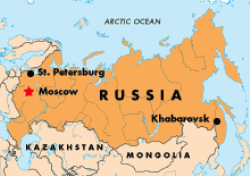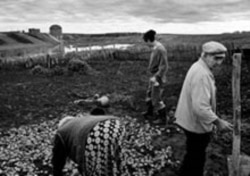Prague, 14 December 2005 (RFE/RL) -- "We no longer expect anything good out of life. When [the village of] Kurmanovo was moved away from the contaminated river, I came on a bulldozer to clear the banks. I drove through the river many times. I've probably been ill since 1974. I ache all over, my bones are all twisted, I've broken my leg. I'm tired. I have to use crutches, that's how I get around."
That was Vafir Gusmanov, a former tractor driver, in the village of Muslim in 2001. He died later that year.
In 1957, a container of radioactive waste exploded at Mayak, the result of a cooling failure. Witnesses reported hearing a sound like a bomb, and then watching a burning red circle rising into the sky.
The explosion sent clouds of high-level radioactive gas into the atmosphere. An intense fog spread across villages, vegetable fields, and the Techa River, the region's sole source of drinking water, and already the repository of years of radioactive dumping.
Information about the explosion was scarce. Some villages were eventually evacuated, like Kurmanovo, where Gusmanov was ordered to clear the river banks. But others were left untouched.
By current estimates, more than 270,000 people have been exposed to high levels of radiation as a result of accidental and deliberate releases of radioactive material from Mayak.
Health Concerns
Dutch photojournalist Robert Knoth traveled to the region in 2000 and 2001. In a recent interview with RFE/RL's Tatar-Bashkir Service, he spoke about the hopelessness of the people he met in the ethnic Tatar village of Muslim -- or Muslimovo as it is called in Russian -- and other places near Mayak.
"Wars you can end; hungry people you can feed. But in places like Mayak, there's hardly any escape, because a lot of people don't have the means to leave the place," Knoth said. "They have to live there for the rest of their lives. They live in contaminated areas. As soon as your children are born, they get affected. There's this constant threat that as soon you have a meal, it might be polluted; as soon as you walk to the river, it might be polluted."
Knoth documented the lives of many of the 2,500 villagers living in Muslim. The vast majority suffer from chronic ailments like heart disease, high blood pressure, arthritis, and asthma. Acute leukemia and other forms of cancer are increasingly common. Nearly half the adult population is sterile, and one-third of babies are born with physical disorders.
It was not until the glasnost period that residents of the Mayak region learned officially about the explosion and about the regular river dumping of nuclear waste. Even now, however, few people receive government compensation for their illnesses, whose ties to radiation exposure cannot always be directly proven.
Elvira Gainullina is a single mother with three children, all of them seriously ill. When she met Knoth in 2001, she was working two jobs in order to support her family, but said she was still barely able to afford even a bus ticket to take her children to see the doctor.
"To be honest, it seems to me we're not living, we're existing. My older son is 15. About three years ago he started getting nosebleeds. My daughter has what they call a 'wandering kidney.' She's not going to have a normal future as a woman [she's infertile]," Gainullina said.
Court Case
Few residents of Muslim have managed to win claims against Mayak. But this year, a criminal investigation was launched against Mayak after an inspection revealed the plant was violating environmental protection regulations.
Despite growing outrage over Mayak's past environmental transgressions, the plant continues to dump radioactive waste into the Techa River -- more than 10 million cubic meters of it every year.
A trial in the case opened in late November in Chelyabinsk, the region's main city, itself just 60 kilometers from Mayak. The Urals regional prosecutor's office filed an inquiry into whether the general director of the plant should face criminal charges.
But government officials still view the plant more as a profitable industry center than a public liability. Mayak has taken on a new role, storing and reprocessing spent nuclear fuel brought in from abroad -- a plan Moscow hopes will add billions of dollars and rubles to federal coffers.
The scheme has caused outrage among residents of Chelyabinsk Oblast.
Sergei Kirienko, the newly appointed head of Russia's Federal Atomic Energy Agency, has acknowledged mounting concerns about Mayak's impact on the environment.
But during a visit to the region yesterday, he said Mayak was vital for the country's economic development and would not be closed.
Knoth says many villagers in places like Muslim accuse the government of helping ethnic Russians to leave while forcing Tatars and other minorities to stay behind despite the obvious health risks.
"In and around Mayak, there are big plans to import nuclear waste and store it in Mayak. And a lot of people we spoke to feel that because they are Tatar they are not important," Knoth said. "Because they're not Russian, they're secondary citizens. And a lot of people say this factory would not have been built in the close vicinity of Moscow, because the government knew what was going on and they on purpose built it in the remote regions of Russia."
Knoth and the environmental watchdog Greenpeace have taken his exhibit to a number of Western countries.
More importantly, they have also staged exhibitions in Russia -- including cities like Kazan and Tomsk, where new nuclear projects have been proposed.
This, Knoth said, gave residents a chance to learn about the risks associated with nuclear plants, and to speak out against the future development of such facilities in their regions.
They are desperate to avoid what Knoth and Greenpeace call the "half-life" of people like the villagers of Muslim.
RFE/RL's Tatar-Bashkir Service contributed to this report
Russia's Nuclear Power Sector
 Click on the map to view the locations of Russia's civilian nuclear power plants.
Click on the map to view the locations of Russia's civilian nuclear power plants.
POWER OF THE ATOM: As Russia's economy recovers from the collapse of the 1990s, the government is moving forward with plans to expand its nuclear-energy sector. Russia currently has 31 civilian nuclear-power reactors in operation, with the newest being Kalinin-3, which came on line in 2004. Nuclear power accounts for 16 percent of Russia's total power generation. Three additional reactors are currently under construction.
Many of Russia's reactors are quite old. In 2000, the government announced plans to extend the working lifetime of 12 first-generation reactors. So far, seven of these reactors have been upgraded for 15-year extensions and all 12 of them are expected to be replaced by 2020.
Russia controls about 4 percent of the world's known uranium deposits, producing some 2,900 tons of uranium in 2002. Russia has four operating uranium-enrichment plants, the largest of which is located at Novouralsk near Yekaterinburg.
The government has not yet approved a proposal for a permanent nuclear-waste storage facility on the Kola Peninsula.
















